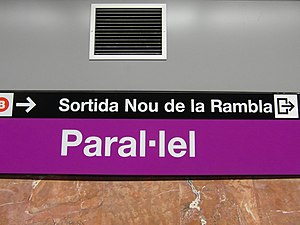Benutzer:Predatorix/Ll
Wenn du dies liest:
|
Wenn du diesen Artikel überarbeitest:
|
Ll/ll ist ein Digraph der in verschiedenen natürlichen Sprachen auftritt.
Englisch
Im Englischen repräsentiert ll oft den selben Laut wie ein einzelnes l: /l/. Die Dopplung wird verwendet um anzuzeigen, dass vorstehende Vokal (historisch) kurz, oder dass der "l"-Laut länger gesprochen werden soll als ein einzelnes "l" würde (etymologisch, in latinisms coming durch eine Gemination kommend). Es ist erwähnenswert, dass verschiedene englische Sprachtraditionen "l" und "ll" unterschiedlich umsetzen: Zum Beispiel werden "travelled" und ähnliche Worte im britischen Englisch mit "ll" im U.S.-amerikanischen Englisch für gewöhnlich aber nur mit "l" geschrieben.
Walisisch
Im Walisischen steht ll für einen stimmlosen alveolar-lateral-frikativen Laut. Das IPA kennzeichnet diesen Laut mit [ɬ]. This sound is very common in place names in Wales because it occurs in the word Llan, for example, Llanelli, where the ll appears twice, or Llanfairpwllgwyngyll, where the ll appears three times.
Im Walisischen ist 'Ll' vom Buchstaben L (e.g. lwc sorts before llaw) zu unterscheiden. Dies führte to its ligature being included in the Latin Extended Additional Unicode block. The capital ligature appears similar to a joined "IL" and the minuscule ligature like "ll" joined across the top.[1] This ligatured character is not used in Modern Welsh.
Spanisch
In Spanish, ll was considered a digraph from 1754 to 2010 as the vierzehnter Buchstabe des Spanischen Alphabets because of its representation of a palatal lateral articulation consonant phoneme (wie von der Königlichen Akademie der Spanischen Sprache definiert).
- This single letter was called "elle," pronounced "elye," but often losing the /l/ sound and simplifying to "eh-ye."
- This letter was collated after L as a separate entry, from 1803 until April 1994, after a vote in the X Congress of the Association of Spanish Language Academies ruled for the adoption of the standard Latin alphabet collation rules. Since then, the digraph ll is now considered a sequence of two characters. A similar situation occurred with the Spanish-language digraph ch.
- Hypercorrection leads some to wrongly capitalize it as a single letter, (*"LLosa," as with the Dutch IJ, instead of the official "Llosa"; "LLOSA" is the right form in full uppercase). In handwriting, it is written as a ligature of two Ls, with a distinct uppercase and lowercase form. An old ligature for Ll is known as the "broken L", which takes the form of a lowercase l with the top half shifted to the left, connected to the lower half with a thin horizontal stroke. This ligature is encoded in Unicode at U+A746 (uppercase) and U+A747 (lowercase) and displayed (by the browsers that allow it) Ꝇ and ꝇ respectively.
- Today, most Spanish speakers outside of Spain pronounce ll as virtually the same sound as y, a phenomenon called yeísmo.
- As a result, in most Spanish-speaking parts of the Americas as well as in many regions of Spain, Spanish speakers pronounce it /ʝ/ (voiced palatal fricative), while some other Spanish speakers in the Americas (especially Colombian and Rioplatense speakers, and in Tabasco, Mexico) pronounce it /ʒ/ (voiced postalveolar fricative) or /ʃ/ (voiceless postalveolar fricative).
Galizisch
In der offiziellen galizischen Rechtschreibung steht die Kombination ll für das Phonem /ʎ/ (lateraler palataler Approximant, ein palatales Gegenstück zu /l/).
Katalanisch

In Catalan, ll represents the phoneme /ʎ/. For example, as in llengua "language" or "tongue", enllaç "linkage", "connection" or coltell "knife". In order to not confuse ll /ʎ/ with a geminated l /ll/, the ligature ŀl is used with the second meaning. For example, exceŀlent is the Catalan word for "excellent", from Latin excellente. In Catalan, l·l must occupy two spaces, [citation needed] so the interpunct is placed in the narrow space between the two L: ĿL and ŀl. However, it is more common to write L·L and l·l, occupying three spaces; this practice is not correct although it is tolerated. [citation needed] L.L and l.l are incorrect and not accepted. See interpunct for more information.
Philippinische Sprachen
While Philippine languages like Tagalog and Ilokano write ly or li in the spelling of Spanish loanwords, ll still survives in proper nouns. However, the pronunciation of ll is simply [lj] rather than [ʎ]. Hence the surnames Llamzon, Llamas, Padilla and Villanueva are respectively pronounced [ljɐmˈzon]/[ljɐmˈson], [ˈljɐmas], [pɐˈdɪːlja] and [ˌbɪːljanuˈwɛːba]/[ˌvɪːljanuˈwɛːva].
Furthermore, in Ilokano ll represents a geminate alveolar lateral approximant /lː/, like in Italian.
Albanisch
Im Albanischen steht L für den Laut /l/, wohingegen Ll wie der velarisierte Laut /ɫ/ ausgesprochen wird.
Isländisch
Im Isländischen repräsentiert "ll" entweder die Lautkombination [tɬ] (ähnlich einem stimmlosen alveolaren lateralen Affrikat) oder [tl], abhängig vom Kontext.[2] Sie tritt in den Worten "fell" (kahler oder kleiner Berg), "fjall" (Berg), und "jökull" (Gletscher, Eiskappe), und daher in den Namen vieler geografischer Erscheinungen auf, einschließlich Eyjafjallajökull.
Verschiedenes
In der Gwoyeu Romatzyh-Romanisierung des Mandarin, zeigt ein abschließendes -ll einen fallenden Ton bei einer Silbe ending in /ɻ/, die ansonsten -l .
Im zentralalaskischen Yup'ik und der gröländischen Sprache steht ll für /ɬː/ und in Haida (Bringhurst-Orthografie) wird es zu /ˀl/ glottalisiert.
Siehe auch
- Lh (digraph)
- Lj (digraph)
- Hungarian ly
Einzelnachweise
- ↑ Everson, Michael & al. "Proposal to add medievalist characters to the UCSBitte entweder wayback- oder webciteID- oder archive-is- oder archiv-url-Parameter angeben". 30 Jan 2006. Accessed 29 January 2013.
- ↑ Language Log. Abgerufen im 20 September 2014.
